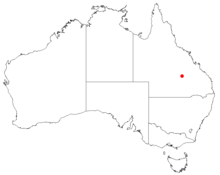Homoranthus coracinus
Homoranthus coracinus is a plant in the myrtle family Myrtaceae and is endemic to a small area in Queensland. It is a low, spreading shrub with pointed, narrow egg-shaped leaves and groups of up to six flowers with black petals. It is only known from a single population in the Ka Ka Mundi part of the Carnarvon National Park.[2][3]
| Homoranthus coracinus | |
|---|---|
| Scientific classification | |
| Kingdom: | Plantae |
| Clade: | Tracheophytes |
| Clade: | Angiosperms |
| Clade: | Eudicots |
| Clade: | Rosids |
| Order: | Myrtales |
| Family: | Myrtaceae |
| Genus: | Homoranthus |
| Species: | H. coracinus |
| Binomial name | |
| Homoranthus coracinus | |
 | |
| Occurrence data from AVH | |
Description
Flowers April, May and September.Distinguished by its pendulous flowers, orange bracteole and dark purple to black sepals.[4]
Taxonomy and naming
Homoranthus coracinus was first formally described in 2000 by Anthony Bean from a specimen collected in the Ka Ka Mundi National Park (now park of Carnarvon National Park) in 1999. The description was published in Austrobaileya.[5] The specific epithet (coracinus) is a Latin word meaning "ravenlike" or "black as a crow",[6] referring to the colour of the petals.[2]
Distribution and habitat
Endemic to Mount Mooloolong area in Carnarvon National Park, central Queensland. Grows in heath on shallow soils on a sandstone outcrop.[4]
Conservation status
Known from a single population. Bean (2000) species considered endangered. ROTAP code of 2ECit using Briggs and Leigh (1996) IUCN (2010) considered 'Endangered'.[4]
References
- "Homoranthus coracinus". World Checklist of Selected Plant Families (WCSP). Royal Botanic Gardens, Kew.
- Bean, Anthony (2000). "Homoranthus coracinus". Austrobaileya. 5 (4): 687–689.
- Copeland, Lachlan M.; Craven, Lyn A.; Bruhl, Jeremy J. (2011). "A taxonomic review of Homoranthus (Myrtaceae:Chamelaucieae)". Australian Systematic Botany. 24 (6): 372. doi:10.1071/SB11015.
- Copeland, Lachlan M.; Craven, Lyn A.; Bruhl, Jeremy J. (2011). "A taxonomic review of Homoranthus (Myrtaceae: Chamelaucieae)". Australian Systematic Botany. 24 (6): 351. doi:10.1071/SB11015.
- "Homoranthus Coracinus". APNI. Retrieved 23 August 2018.
- Brown, Roland Wilbur (1956). The Composition of Scientific Words. Washington, D.C.: Smithsonian Institution Press. p. 148.